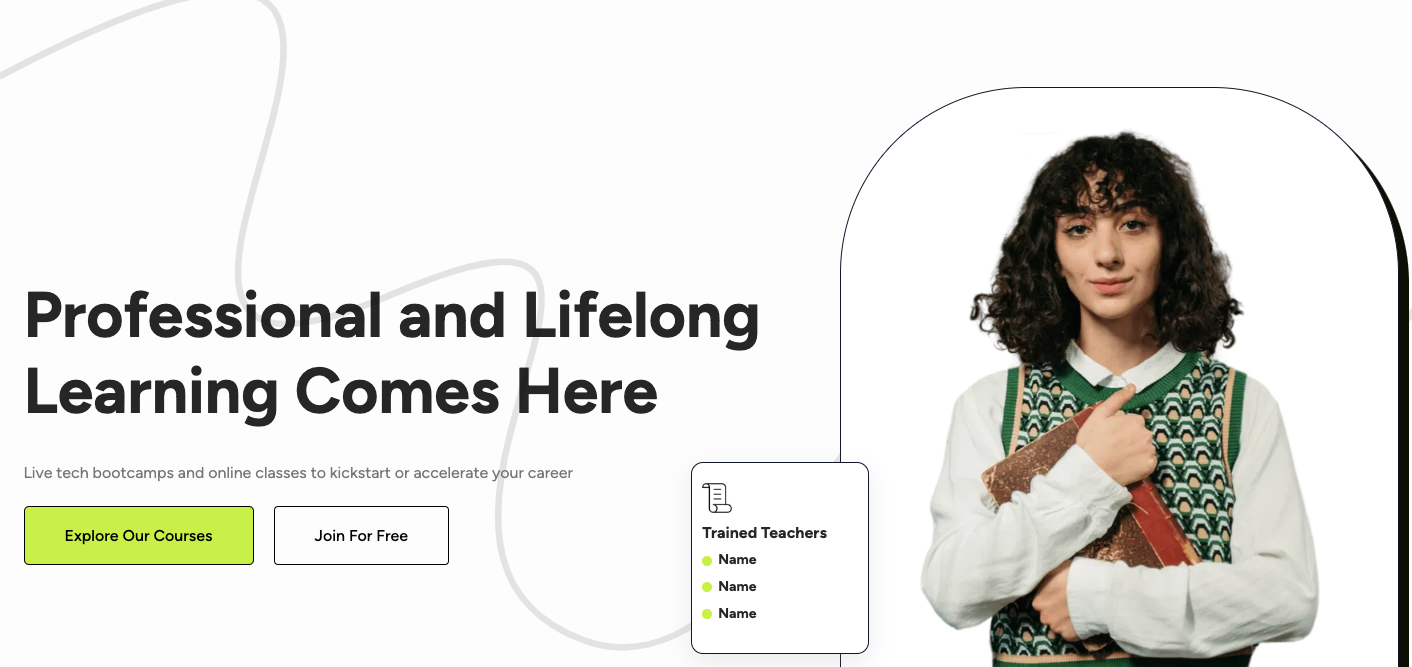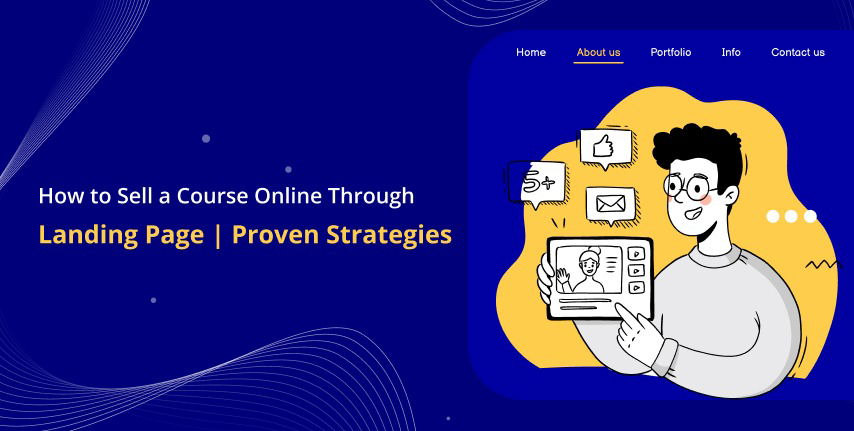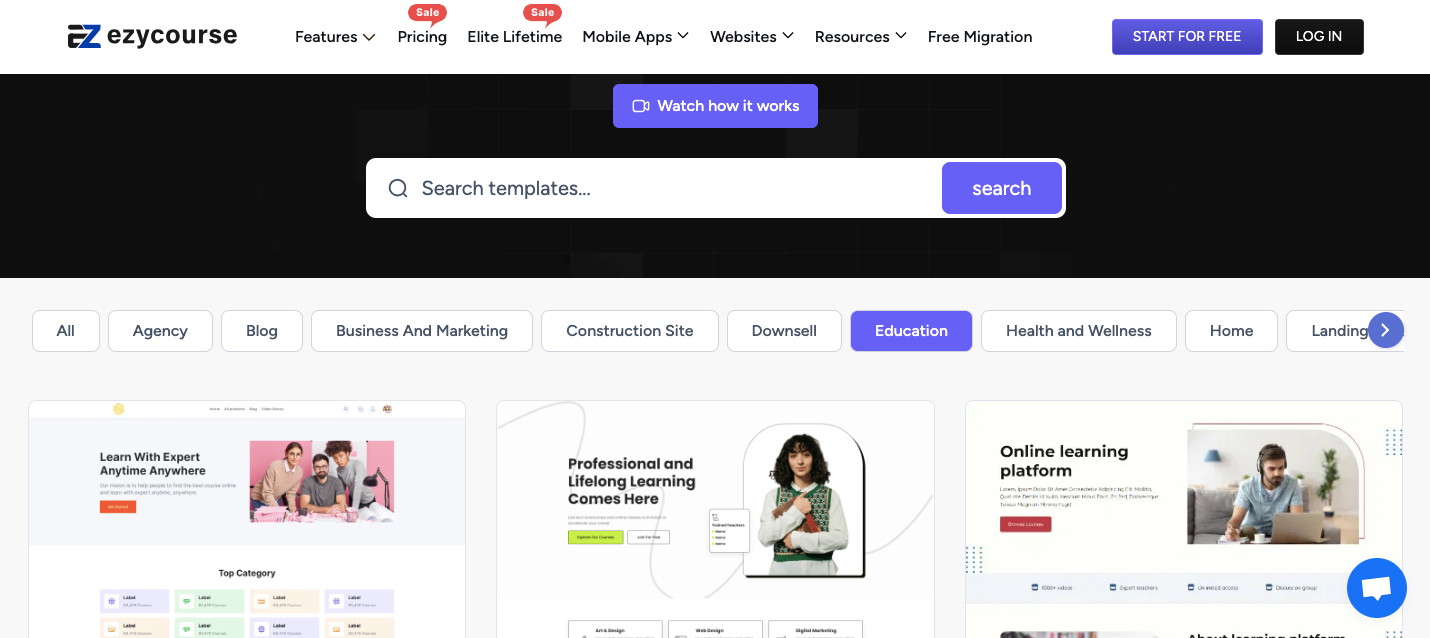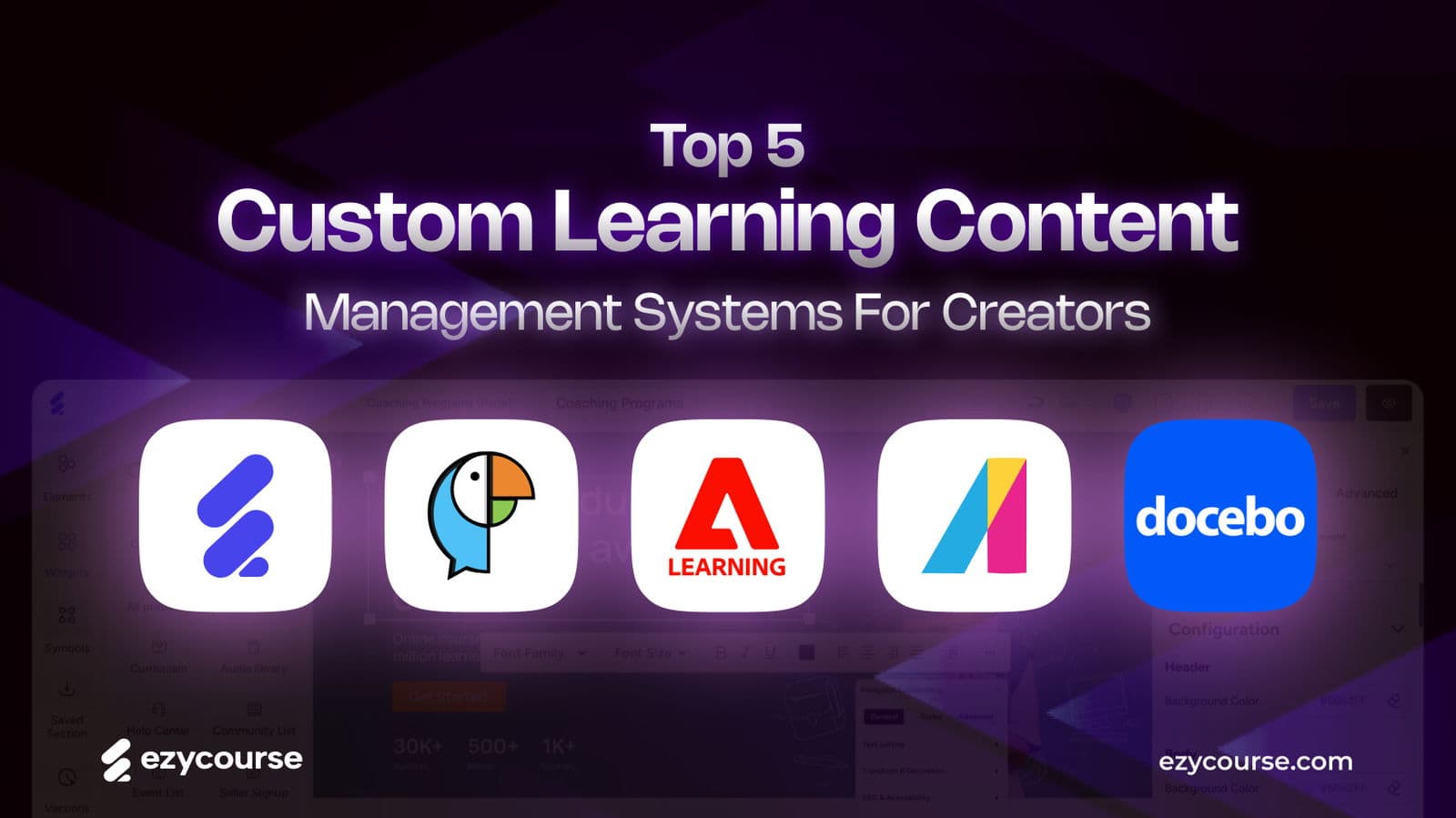Selling courses online has become one of the modern and effective income-generation methods. As everything around us becomes digitized daily, people are becoming more motivated to learn online.
However, selling a course online can be tricky if you don't know how to begin with it. In today's article, you will get a step-by-step guide on how to sell a course online through a landing page. You can begin your passive income generation journey by following this guide and customizing it according to your needs.
So, without further ado, let's get into the details.
What Is a Landing Page for Selling Courses?

A landing page for selling a course is a single page on your website dedicated to selling the course. It differs from your website’s homepage, about page, or product pages. The sole purpose of this page is to inform readers about your course in detail so that they become convinced to validate it and buy it.
The landing page turns a visitor into a customer, so it needs to be well-written, well-designed, and well-decorated. It should also cover everything the customer needs to know to buy the course.
An ideal landing page for courses should have the following characteristics.
Clear Headline
The headline is the first thing visitors see on your course landing page. So, it must be attention-grabbing and state what your course is about. Suppose you are selling a course to make people learn how to code. You can go for this title or headline, "Learn to Code in 12 Weeks and Land Your Dream Job."
Compelling Subheadline
Once the reader is hooked on the headline, they look for more context and clarity. That's where a persuasive and engaging subheading can play a role. The ideal landing page must have intriguing subheadings that address the removal of distress for the readers and consumers.
High-Quality Visuals
Your landing page should contain high-quality visuals even though you are selling a very basic course. Do not use just any stock photos. Instead, use images and videos that represent your course to the audience appealingly.
Fast Loading Speed
A slow-loading landing page can negatively impact user experience and conversion rates. So, the landing page should be hosted on a reliable web hosting provider with optimized images and shorter codes.
Clean And Uncluttered Layout
Clarity is one of the most important things a landing page needs for conversions. Keep the design simple and avoid overcrowding the page with too many elements. Use white space effectively to create a clean and visually appealing layout.
Benefits of Using Landing Pages to Sell Courses
Using landing pages can provide multiple benefits to a course creator's business. Here are some of the most crucial ones.
1. Targeted Traffic
Gathering targeted people to sell your course is one of the most vital things in business. It saves you time and money. An optimized landing page can help you generate that targeted traffic and save from hassle.
2. Improved Conversion Rates
A landing page is designed carefully and specifically for your courses and gives the customer exactly what they want. When they visit your landing page and see the details, they are clear about what you are offering and what benefits they can get. This improves your conversion rate by turning visitors into paying customers.
3. Data Tracking and Analytics
Trying to sell a course with a landing page rather than your website's regular page gives you some bonuses. You can track key metrics like conversion rates, bounce rates, and click-through rates. That's how you know where to tweak and improve for better sales.
4. Better Lead Generation
Landing pages can capture leads, such as email addresses, for future marketing efforts. Then, you can send them your free newsletter or other freebies to attract more customers.
5. Reduced Marketing Costs
A single landing page helps in cutting the cost of marketing. When you can take the marketing approach with the landing page, the spending on unoptimized ads decreases.
The 10-Step Guide on How to Sell a Course Online Through Landing Page

Creating a landing page requires time and attention. Which template works best depends on your business model and course structure. However, the following are most of the ideal steps for landing pages for selling courses.
1. Find Out Your Target Audience
Finding your target audience is the first and most important factor to consider while creating a landing page. Your target audience can be future customers at any time. They are the people who might need your assistance to achieve their goals.
Once you know your target audience, you can create structured content for your landing page that might help them convert into buyers. As a course creator, you must focus on four key questions to determine your target audience.
Who are your ideal students?
What are their pain points and challenges?
What are their motivations for taking the course?
Where can you find your target audience?
To find out the answer, think about your course. If we consider the first question, for instance, you are a digital marketing coach and selling a course on that. Then, your target audience would be small business owners, freelancers, or social media influencers who need help in marketing.
To answer the second question, let’s say you are selling a course about time management. Then, the major pain points of your audience might be procrastination and being overwhelmed with workload. So, address these pain points on your landing page and showcase a promise to help them resolve the issue.
Consider what your students might seek and what benefits they look for. For example, you are selling a course on personal finance. Then, your ideal student might be looking to achieve financial independence or save for a major purchase.
Last but not least, figure out where you can find your ideal audience. If your course is on photography, you might find your students on social media like Instagram or Flickr and photography forums. So, customize your landing page according to their needs.
2. Work On Your Hero Section - The Heading
The hero section of a landing page is the over-the-fold content that your audience will see first. The content and heading of this section could be different if you want to do that. However, no matter how you use it, this section must be engaging and catchy.
Here are some key elements for a strong hero section:
Clarity
When you go to a store to buy something, you look for all the possible information about the product, right? So that you can make an informed decision about whether to buy or not. That's exactly the same in terms of landing page headings.
The headline should clearly communicate the value proposition of your course. Besides, avoid using confusing and lengthy headings that don't talk precisely.
Conciseness
The shorter the headline, the better attention you get on your landing page. Use short sentences with words that reflect your brand identity and course content together. Aim for a headline that is no more than 70 characters long.
Relevance
Do not input too much detail in the heading, and stay relevant. Avoid using unnecessary information or information that you can later add to a subheading or in the description.
Urgency
Urgency is a very common and efficient marketing tactic that always works in business. You can offer limited-time offers to quick purchases for your students. Besides, you can offer early bird discounts for your buyers to generate sales quickly.
Benefits-Oriented
This is another important factor to showcase in your landing page heading. Always try to sell the benefit to the buyer, not the feature. Suppose you are a mindfulness coach. You can say, "Declutter and manage your thoughts in blocks within 15 days." Or, "Make more time for leisure by working on time without procrastination with a 15-day Mindfulness journey."
Here, mindfulness's benefits are decluttering and managing thoughts or eliminating procrastination.
Emotional Appeal
To strengthen your connection, tap into your target audience's emotions. For example, you could use phrases like "Achieve Your Dreams" or "Take Control of Your Future."
3. Optimize The Subheadings
The subheading is the next section your readers see after the hero section and main heading. It is where you elaborate and give visitors more ideas about your course.
Just like your main heading, your subheading needs to be visually appealing and informative but not congested with difficult words and long sentences. Keep it simple and add necessary information in easy-to-understand words and precise sentences.
Key Points to Keep in Mind While Creating the Subheadings
Even if your course includes technical aspects, create subheadings using simple and nontechnical terms. Express the critical items with easy words.
Your subheadings should directly relate to the main headline. Provide additional context or information.
Optimize your subheading for SEO to achieve search engine ranking and audience attention.
Use headings at different levels (e.g., H1, H2, H3) to create a clear information hierarchy.
You can use strong action verbs to create excitement among readers or urgency of buying.
Be consistent with the formatting style of your subheadings throughout the page.
4. Write Engaging Description Copy
Your landing page's description copy must be persuasive, informative, and engaging. It must have the quality to convince the visitors to enroll. It's the section where you craft actionable words and make the readers fully informed about your course.
Key Elements of Effective Description Copy
Clear and Concise Language
Your target audience must understand your language for better conversion. Never use large blocks of text to write a copy of your description. Use precise and easy-to-understand sentences. Besides, avoid using terms that are too technical to make people understand your course.
Highlight Key Benefits
In the copy, you have to talk about the features, right? But, tell them in the form of benefit. You can highlight the benefits that your previous students got because of specific features. Try to use numbers and data-driven statistics to highlight benefits.
Use Storytelling
Try to write your description copy in a storytelling form. This will help it resonate more with your target audience and illustrate the value of your course. In the concept, address their hopes, fears, and desires.
Use Social Proof
Share positive feedback from satisfied students. Showcase the popularity of your course. Mention the certifications and awards you got as an instructor for social proof.
Break Up Text with Visuals
Last but not least, use visuals to make the text more understandable and scalable. Visuals can help to break up the text and make your landing page more engaging.
5. Add Social Proofs And Testimonial
We've already talked about social proof for description copy. You can use them to build trust and credibility with potential students. Let's discuss the kinds of social proofs you can use on your landing page.
Types Of Social Proof
Socia proof can be in several forms ranging from testimonials, reviews, case studies and so on.
1. Testimonials
You can ask your previous batch of students for testimonials and include them on your landing page. Ask them to write about what they have liked the most about your course and how that has helped them improve their situation.
For example, suppose your course teaches how to be a professional writer. A testimonial can say, "I highly recommend this course to anyone looking to improve their writing skills. The lessons were clear, informative, and engaging. I've already improved significantly and have landed successful writing gigs." - Sarah Smith, Satisfied Student.
2. Reviews
You can include one-line reviews with star ratings from the students. Here, students can rate using stars out of 5 or 10 and write a one-line review of the course.
3. Case Studies
You can portray your students' success stories. For example, if you teach students Digital Marketing, you can tell your audience how they have learned through the journey and implemented the practices you taught. Besides, don't forget to use the number of revenue generated by their business.
4. Social Media Shares
You can create shares and social media icons on your landing page. Then, put the numbers of how often they have been shared across different social media platforms.
6. Include a Clear and Concise Call to Action (CTA)
A landing page's CTA (Call to Action) is as important as the heading or description. Once your potential students or buyers are convinced about you, the CTA text will intrigue them to enroll then and there. So, you have to cart it mindfully.
Key Elements of a Strong CTA
Clarity And Conciseness
CTAs are created to make the visitors understand to take the next step. So, the CTA text must be clear and concise, at most 3 to 4 words.
Urgency And Scarcity
Focus on why your course is exclusive or has a limited number of available spots. Use phrases like "Limited Time Offer" or "Don't Miss Out." You can also use a visual of a countdown timer.
Visibility And Contrast
Position your CTA above the fold or in a highly visible area on the landing page. Create a button that is easy to click and visually appealing. Besides, consider an attractive color palette for the button that makes it pop out on the landing page.
Action-Oriented Language
Use active voice to make your CTA more impactful. Use verbs like "enroll," "register," "sign up," or "download."
7. Add Eye Catchy Visuals
Visuals are one of the most important things besides headings and descriptions. Even someone who doesn't want to read through much of your landing page would see the visuals by scrolling.
So, the visuals on your landing page must be able to draw the viewer's attention and convey the message. Here are some key elements that the visuals must have.
Key Elements of Effective Visuals
Choose images that are relevant to your course. It should showcase some benefits.
Use high-resolution videos, images, and info-graphics that are visually appealing.
Make sure the visuals project your brand identity.
Try to design the visuals with an emotional approach towards your target audience.
Do not overcrowd your landing page with visuals, and keep them meaningful.
Types of Visuals to Use -
Course-Related Images that reflect what your course is about. You can also use gifs that show the cycle of your course, like starting the course to achieving success.
You must use the instructor's photos to connect deeper with the students.
Use photos of your previous students with graphics that talk about their success.
Use visual representations of data or statistics related to your course.
You can add videos recorded by you and co-instructors to welcome the students and brief them about the course.
8. Manage The Back End - The Web Design
The back end refers to what makes the website work and look good for viewers. Codes, designs, and other functionality make a suitable landing page. So, you must work on the back end properly so that the front end looks perfect.
Key Elements Of A Well-Designed Back End
Follow these factors while managing the back-ends of your website.
Responsive Design
While working on the back end, ensure your landing page is responsive. Optimize the page for all devices and ensure all the buttons and navigation work properly. Besides, work on the image sizing so that they adjust to the device screen requirements.
Fast Loading Speed
Slow loading often includes the risk of a high bounce rate. Visitors do not like landing pages that take too much time to load and lose interest in seeing the content. That's why optimizing your landing page for fast loading speed is essential.
User-Friendly Layout
Create a user-friendly layout so viewers can easily read through the page. This means organizing the texts in an easy-to-read and scannable manner. Arrange the images in specific spaces where needed, and highlight CTA buttons multiple times on the page. Besides, optimize the above-the-fold content well and make the navigation space more accessible.
SEO Optimization
Optimize the landing page for SEO with SEO best practices. Conduct thorough keyword research, accurately place keywords, and create relevant internal linking. Ensure your landing page is SEO optimized for mobile and other devices.
Security And Analytics Integration
Make security arrangements strictly for your landing page. Use HTTPS to encrypt data transmitted between your server and visitors' browsers. Track bounce rate, conversion rate, time on page, and the number of visitors to your landing page and their source.
9. Integrate With Other Tools
Integrating your landing page with the tools required for conversion is necessary. You have to select the tools carefully and look for easy integration.
Key Tools to Consider Integrating With Your Site
You can consider using these tools to integrate into your platform.
Email Marketing Software
Even though the visitor does not turn into a customer, he can still be your target audience for the future. To stay relevant to potential buyers of your course, you have to be seen by them often. That's when targeted promotional emails can work. To send them those, you need their email. So, integrate email marketing software with your landing page to effortlessly capture visitors' emails.
Payment Processors
You can sell your course directly on the landing page. You need a reliable payment gateway to do so safely and without any hassle. Choose a reputed payment gateway and make sure to integrate it with security on your landing page to receive payments.
Live Chat Software
When people visit a landing page, they like to get their questions answered immediately. Although you write everything in detail on the landing page, the target audience might have more to ask. That's why integrating live chat software into your landing page is necessary, as it allows you to provide real-time solutions in no time.
10. Promote The Landing Page
Once you have created your landing page, it's time to promote it. Using relevant hashtags and engaging visuals, you can promote your course and landing page on platforms like Facebook, Twitter, LinkedIn, and Instagram.
Besides, you can run paid targeted ads on social media to reach your targeted customers better. Remember to add a social sharing button on your landing page for easier access to sharing the page.
How to Sell a Course Online Through Landing Page With EzyCourse
EzyCourse makes selling courses online through a landing page a seamless experience. Whether you're creating a custom landing page with our web builder or using the default one, the process is simple and effective.
Creating a Custom Landing Page with EzyCourse Web Builder
If you prefer to build your own landing page from scratch, EzyCourse’s web builder provides a drag-and-drop interface, allowing you to create a custom landing page that reflects your brand. You can choose from various customizable templates, use various widgets, and add essential elements like course descriptions, testimonials, and high-quality visuals. The web builder gives you the flexibility to adjust layouts, integrate CTAs, and optimize the page for SEO, ensuring your landing page performs well on search engines and provides an engaging user experience.
After creating the landing page using the web builder, you need to add it to your course. Go to Courses -> All courses -> click Edit on the specific course under the Action column. Now, select the Settings sub-menu and go to the Landing Page Settings tab. To change the landing page, simply click the Choose Custom Page button and select the page you want to show as the landing page of this course.
Using the Default Landing Page

For those who prefer a faster route, EzyCourse offers a default landing page template designed specifically for selling courses. The page is designed for simplicity and ease of use, allowing course creators to provide all the essential information in a clear, concise manner. At the top, learners are greeted with the course title and a brief introductory message, followed by key instructor details like the number of chapters and lessons.
On the right side, the pricing section offers flexibility with various payment options and includes a prominent "Enroll Now" button, making it easy for learners to sign up quickly. Additionally, the landing page outlines what the course includes, such as assignments and quizzes, to give learners an idea of what they’ll receive.
The middle section provides a brief course description, followed by a structured breakdown of chapters and lesson types, which could include videos, quizzes, or text-based lessons. This layout ensures that potential students can quickly evaluate whether the course meets their needs, facilitating a smoother conversion process.
You can see the EzyCourse templates from here.
Key Benefits of Using EzyCourse for Your Landing Page
Optimized for Conversions: Both custom and default landing pages come optimized for high conversion rates, ensuring that your course is presented in the best way possible.
Responsive Design: EzyCourse ensures that your landing page looks great on all devices, whether it's a desktop, tablet, or mobile.
SEO-Friendly: With built-in SEO tools, your landing page is ready to rank on search engines, driving more traffic to your course.
By utilizing EzyCourse’s tools, you can create an attractive, professional landing page that resonates with your audience and helps you sell your course effectively.
Conclusion
Selling your course and teaching online can only be profitable when you plan everything accurately. That’s why you need a stunning website or a landing page. We hope that with our guide on how to sell a course online through a landing page, you can now begin the journey.
Choose an all-in-one website creation platform like EzyCourse Website Builder to build your stunning landing page and make your business reach its peak.





